Rocas Alijos (Alijos Rocks) are located 320 km west of Baja California, Mexico. They consist of three volcanic rocky spires: North (29 m high), Middle (18 m) and South (35 m) Rocks along with numerous smaller low-lying rocks that are often awash.
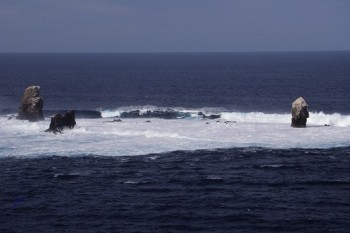
Rocas Alijos
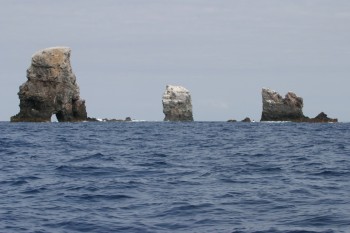
South Rock, North Rock and Middle Rock from left to right
Laysan Albatrosses regularly roost and are presumed to breed on both South and North Rocks
The total exposed surface area on the two rocks (North and South) where Laysan Albatrosses Phoebastria immutabilis are thought to breed is only a hundred square metres or so. There is a small amount of loose soil on top of South Rock, but no terrestrial plants or breeding land birds have been observed. South and Middle Rocks were climbed for the first time in 1990; it appears that a landing has not been made on North Rock.
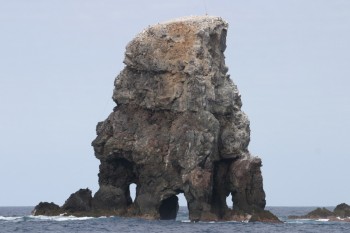
South Rock is severely undermined with daylight visible through the base at all angles. Three Laysan Albatrosses are just visible at its top
Laysan Albatrosses were first recorded at Rocas Alijos in February 1976 when 10 were present; birds were first observed displaying on the water in 1983, and in January 1988 there were 16-18 present when single birds were first observed landing on two of the rocks. Twelve were seen near the rocks in February 1993 and in December 1999 from a helicopter I observed one Laysan roosting on South Rock (Roca Sur) and five on North Rock – one on the latter appeared to be incubating as it stayed in the same position for at least three hours.
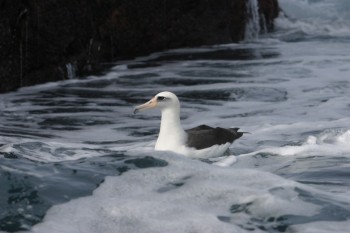
A Laysan Albatross swims in the roiling foam among the rocks at Rocas Alijos
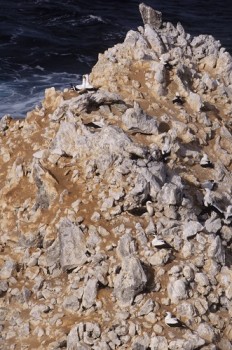
An apparently incubating Laysan Albatross is discernable on North Rock in the aerial photo's centre in December 1999
In December 2003, I counted 28 Laysan Albatrosses associated with the rocks. This is the highest count for the locality and the birds seemed to be either already breeding on North and South Rocks or just preparing to as birds were displaying on the water with three to four pairs considered to be breeding at the time. Laysan Albatrosses occur seasonally at Rocas Alijos: none was seen during visits to the rocks in August 2006 and October 1993.
In addition to Laysan Albatrosses, a single Black-footed Albatross P. nigripes was observed around a boat at Rocas Alijos for two days in February 1993, and a minimum of three were flying between the rocks in December 1999.
Several other seabirds are known to breed on Rocas Alijos, including Red-billed Tropicbird Phaethon aethereus (strongly suspected), both Masked Sula dactylatra and Nazca S. granti Boobies, an as-yet unidentified frigatebird Fregata sp., Sooty Tern Onychoprion fuscata and an unidentified storm petrel Oceanodroma sp.
See ACAP Breeding Site accounts for the Mexican islands supporting breeding Laysan Albatrosses of Clarion, Revillagigedo Archipelago and Guadalupe.
All photographs by R.L. Pitman.
Selected References:
Everett, W.T. & Pitman, R.L. 1996. Avian specimens from Rocas Alijos. In: Schmieder, R.W. (Ed.). Rocas Alijos. Scientific Results from the Cordell Expeditions. Dordrecht: Kluwer Academic Publishers. pp. 359-362.
Howell, S.N.G. & Webb, S.W. 1992. Changing status of the Laysan Albatross in Mexico. American Birds Summer 1992: 220-223.
Pitman, R.L. 1985. The marine birds of Alijos Rocks, Mexico. Western Birds 16: 81-92.
Pitman, R.L., Walker, W.A., Everett, W.T. & Gallo-Reynoso, J.P. 2004. Population status, foods and foraging of Laysan Albatrosses Phoebastria immutabilis nesting on Guadalupe Island, Mexico. Marine Ornithology.
Senf, E. & Wicksten, M.K. 1996. Birds observed at Rocas Alijos. In: Schmieder, R.W. (Ed.). Rocas Alijos. Scientific Results from the Cordell Expeditions. Dordrecht: Kluwer Academic Publishers. pp. 355-357.
Bob Pitman, Southwest Fisheries Science Center, La Jolla, California, USA, 03 February 2013

 English
English  Français
Français  Español
Español